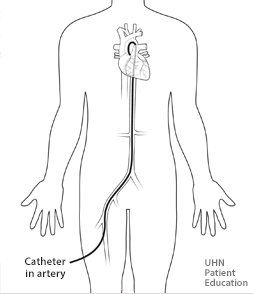
Angiogram through femoral artery
Arteries that feed the heart muscle blood and oxygen are called coronary arteries.
An angiogram can determine how much narrowing (or blockage) exists in the coronary arteries.
- During this procedure, a thin tube called a catheter is inserted from the groin (femoral artery) or wrist (radial artery) up to the heart and to the coronary arteries.
- A dye is then injected through the catheter and allows the doctor to see the blood flow through the coronary arteries, like a roadmap.
See how an angiogram can help your heart doctor find out what is wrong with your heart (opens in new window) »
